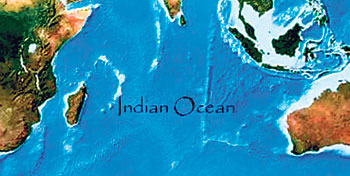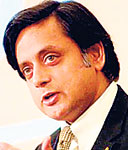NEW DELHI - What international association brings together 18 countries straddling three continents thousands of miles apart, united solely by their sharing of a common body of water?
That is a quiz question likely to stump the most devoted aficionado of global politics. It's the Indian Ocean Rim Countries' Association for Regional Cooperation, blessed with the unwieldy acronym IOR-ARC, perhaps the most extraordinary international grouping you've never heard of.
 |
The association manages to unite Australia and Iran, Singapore and India, Madagascar and the United Arab Emirates, and a dozen other states large and small - unlikely partners brought together by the fact that the Indian Ocean washes their shores. I've just come back (as India's new Minister of State for External Affairs) from attending the association's ministerial meeting in Sana'a, Yemen. Despite being accustomed to my eyes glazing over at the alphabet soup of international organizations I've encountered during a three-decade-long United Nations career, I find myself excited by the potential of IOR-ARC.
Regional associations have been created on a variety of premises: geographical, as with the African Union; geopolitical, as with the Organization of American States; economic and commercial, as with ASEAN or Mercosur; and security-driven, as with NATO. There are multi-continental ones too, like IBSA, which brings together India, Brazil, and South Africa, or the better-known G-8.
Even Goldman Sachs can claim to have invented an inter-governmental body, since the "BRIC" concept coined by that Wall Street firm was recently institutionalized by a meeting of the heads of government of Brazil, Russia, India, and China in Yekaterinburg last month. But it's fair to say there's nothing quite like IOR-ARC in the annals of global diplomacy.
For one thing, there isn't another ocean on the planet that takes in Asia, Africa, and Oceania (and could embrace Europe, too, since the French department of Reunion, in the Indian Ocean, gives France observer status in IOR-ARC, and the French foreign ministry is considering seeking full membership).
For another, every one of Samuel Huntington's famously clashing civilizations finds a representative among its members, giving a common roof to the widest possible array of worldviews in their smallest imaginable combination (just 18 countries). When IOR-ARC meets, new windows are opened between countries separated by distance as well as politics.
Malaysians talk with Mauritians, Arabs with Australians, South Africans with Sri Lankans, and Iranians with Indonesians. The Indian Ocean serves as both a sea separating them and a bridge linking them together.
The potential of the organization is huge. There are opportunities to learn from one another, to share experiences, and to pool resources on such issues as blue-water fishing, maritime transport, and piracy (in the Gulf of Aden and the waters off Somalia, as well as in the straits of Malacca).
But IOR-ARC doesn't have to confine itself to the water: it's the countries that are members, not just their coastlines. So everything from the development of tourism in the 18 countries to the transfer of science and technology is on the table. The poorer developing countries have new partners from which to receive educational scholarships for their young and training courses for their government officers.
There is already talk of new projects in capacity building, agriculture, and the promotion of cultural cooperation.
This is not to imply that IOR-ARC has yet fulfilled its potential in the decade that it has existed. As often happens with brilliant ideas, the creative spark consumes itself in the act of creation, and IOR-ARC has been treading water, not having done enough to get beyond the declaratory phase that marks most new initiatives. The organization itself is lean to the point of emaciation, with just a half-dozen staff (including the gardener!) in its Mauritius secretariat. The formula of pursuing work in an Academic Group, a Business Forum, and a Working Group on Trade and Investment has not yet brought either focus or drive to the parent body.
But such teething pains are inevitable in any new group, and the seeds of future cooperation have already been sown. Making a success of an association that unites large countries and small ones, island states and continental ones, Islamic republics, monarchies, and liberal democracies, and every race known to mankind, represents both a challenge and an opportunity.
 |
| Shashi Tharoor |
This diversity of interests and capabilities can easily impede substantive cooperation, but it can also make such cooperation far more rewarding. In this diversity, we in India see immense possibilities, and in Sana'a we pledged ourselves to energizing and reviving this semi-dormant organization. The brotherhood of man is a tired cliché, but the neighborhood of an ocean is a refreshing new idea.
The world as a whole stands to benefit if 18 littoral states can find common ground in the churning waters of a mighty ocean.
Shashi Tharoor, Minister of State for External Affairs in the Government of India, is a former Under Secretary General of the UN and an award-winning novelist and commentator.
Copyright: Project Syndicate, 2009.
Exclusive to the Sunday Times
Member states
Founding member states (March, 1995):
Australia, India, Kenya, Mauritius, Oman, Singapore, South Africa
Joined in September 1996 :
Indonesia, Malaysia, Madagascar, Mozambique, Sri Lanka, Tanzania, Yemen
Joined in March 1999 :
Bangladesh, Iran, Thailand and the United Arab Emirates
Dialogue Partners :
China, Egypt, France, Japan and the United Kingdom |


